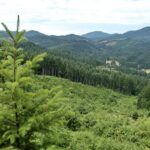Making Forests the go-to Natural Capital Investment Solution
As investors scramble with how to allocate funds to a green transition, we (investment professionals specializing in climate friendly options) have a job to do. We need to make it easy for these investors to deploy capital quickly.
In an article I read recently in Corporate Knights, the title reads: Slow and steady will not win the climate race – we need more corporate leaders to go all-in on climate action, investing as much as possible as fast as possible to be at the heart of climate solutions. Though we (forest investment professionals) have long known how suitable forest investments are as part of the solution to this mounting challenge – we are not doing a good job at breaking down the barriers to entry for new investors to the asset class. In this week’s article, I identify some low-hanging fruit on how we can quickly both 1.) inform investors about the asset class and 2.) make it easy for them to invest.

Inform Investors
I have seen investors avoid the asset class from the very outset because they 1.) don’t understand it and 2.) evaluate an investment opportunity for a year or more to eventually walk away from it because they can’t get comfortable with the underlying assumptions (I revert back to reason 1). It’s our job to inform them of the fundamentals:
Forest investment Principles: I discussed these briefly in my previous article on motivations for investing in forests – these are: Low correlation to other asset classes, biological growth – the asset builds value, simply by growing, market flexibility – in times of low wood prices you can choose not to harvest and wait for better markets, and long-term stable income streams.
Evaluation of forest assets: This is a big one. Unless there is in-house experience with forest investments, investment teams that sit in the alternatives, real assets, and impact investment teams have a difficult time navigating the cashflow model and appraisals of a forest asset. This is especially challenging in emerging markets, where comparative sales are non-existent. The most challenging part is evaluating how much pre-commercial forests are worth – and this is where traditional timber markets are alive and well. If you throw into the mix, the asset value based on climate and intrinsic biodiversity values – investors are really going to scratch their heads. We need to help investors understand how to evaluate forest assets.
Risk reduction: We live in an age of mass media, and the media loves to sensationalize wildfires, orphaned koalas, and human rights violations against forest-dwelling indigenous groups. These unfortunately are real events – but they are not the norm in sustainable forestry, and investments into sustainably managed forests reduce risks like these from eventuating. However, for the uninformed investor – they literally visualize their investment capital going up in smoke. It is your job to identify these common risk perceptions held by investors and provide them with the information/evidence as to how such risks can be avoided or mitigated by your strategy. Furthermore, to explain the risks of inaction – for example, wildfires often occur in un-managed forests.
The new Natural Capital asset class: You may be the first to inform an investor of the up-and-coming nomenclature around the asset class, and that is Natural Capital. Essentially nothing changes with regards to the investment case for forestry, it is more a different packaging – but one that is becoming increasingly important for investors to include in their portfolios. You need to be able to describe the merits of this asset class, and how investors can become early-movers in the asset class, as it is only going to gain in traction in the coming decades.
Make it Easy
Information is one thing, but removing friction is another. What do I mean by this? If we’re assuming your target investors include those that are new to forest investment, you need to address their main concerns, of which lack of education on the asset class is one – others are as follows:
- Investment vehicles
- Lower risk via diversification
- High-learning via small direct investments
- Enabling features – like speed of capital deployment, blended finance already committed
- Track record
Investment Vehicles: There are several strategies investors might take to get their feet wet in the asset class, and this will depend largely on the investment mechanisms they have at their disposal. Let’s put aside for a moment, the most obvious fit of equity for forest investments. A natural capital investment fund, or a climate fund might only be able to deploy debt – in such cases, greenfield investments into emerging markets are not the right investment for them. If debt is what the investors have available – credit opportunities for short-term financing of expanding processing facilities, where there is a direct, and near immediate link to revenue generation can be an appropriate solution. Investors may also be able to participate via climate currency – that is carbon returns. Having an investment vehicle that provides flexibility to allow investors to deploy capital in exchange for carbon credits is becoming increasingly more popular. They may be a bank that wants to support their corporate clients by directing them to targeted investment strategies that meet their clients’ carbon credit or biodiversity objectives that are rooted in traditional markets. Provide investors with alternative investment vehicles.
Diversification: A common tactic for investors new to forest investment is to reduce risk via diversification AND through investing with experienced managers. This could be a Fund of Funds – where diversification is maximized, or through Funds, where there is less diversification – but often more control over the assets – an appropriate strategy where the Fund manager has a good track record. Another form of diversification is across different forest asset types, end markets and geographies. Asset types might consider a blend of green/brownfield opportunities, and species compositions. End markets may differ by end wood products – such as sawn timber or manufactured wood products or the incorporation of carbon credits. Investing across different countries or broader core/emerging markets can also provide different diversification opportunities. Provide investors with options to diversify.
Direct Investments: Now this is not going to be the mainstream way for most investors to enter the asset class. However, there are some huge merits of direct investment that cannot be understated. A small direct investment into a forest asset allows investors to gain familiarity with the inner workings of sustainable forest management, and depending on the asset, experience with carbon markets, processing, and ESG issues. Co-investing alongside experienced forest investors, or having a strong partnership with the manager of the asset will allow you to gain invaluable information on the asset class that is difficult to obtain from more arm’s length investment structures like Fund or Fund of Fund investments. Provide investors with hands-on learning experience in the asset class.
Enabling features: This is an extremely broad category, and will depend on the investment vehicle and strategy you are offering, and the specific barriers to entry it may present. Investors might have liquidity concerns with long-term greenfield strategies, or general risk concerns with emerging market strategies, they tend to be averse to complex fund structures and prefer to ‘plain vanilla’ variety, etc. As such, you may consider blending in some cashflow generating assets into your greenfield strategy, and secure simply structured and administered blended finance that both reduces risk and addresses structure simplicity. Have real solutions ready for the most common objections to your investment strategy.
Track Record: Obviously if you have a new forest investment strategy, where you do not have track record, or – if you’ve been operating in challenging jurisdictions and don’t have the greatest track record – all is not lost. For a new strategy, you can bring the missing experience into your team – even better if that experience is local to where the assets will be situated. You can establish partnerships with local players that will strengthen your investment case – this might be in the form of long-term offtake agreements, or civil society organizations, and you can explore insurance. If your track record is not ideal – you need to work harder. You need to identify where you went wrong, and have a concrete strategy to turn things around. Maybe it is not investing into the same types of assets or certain jurisdictions, or it requires re-structuring in your team. Evidence a strong track record or your well thought-out path to it.
Need help with giving investors quick wins?
If you’re designing an investment strategy and are targeting investors new to the asset class, you will want to make the investment decision easy for them. If you need some support in either identifying the information gaps or the barriers to entry in your strategy that might exist, and how to remove them – reach out, and we can find a solution so that you can move toward more effective discussions with your prospects.
Did you like this article? Sign up now for the ForestLink’s newsletter, where you’ll receive technical advice, reflections, and best-practice guidance to support you with your forest-linked investment strategy or business straight to your inbox.





